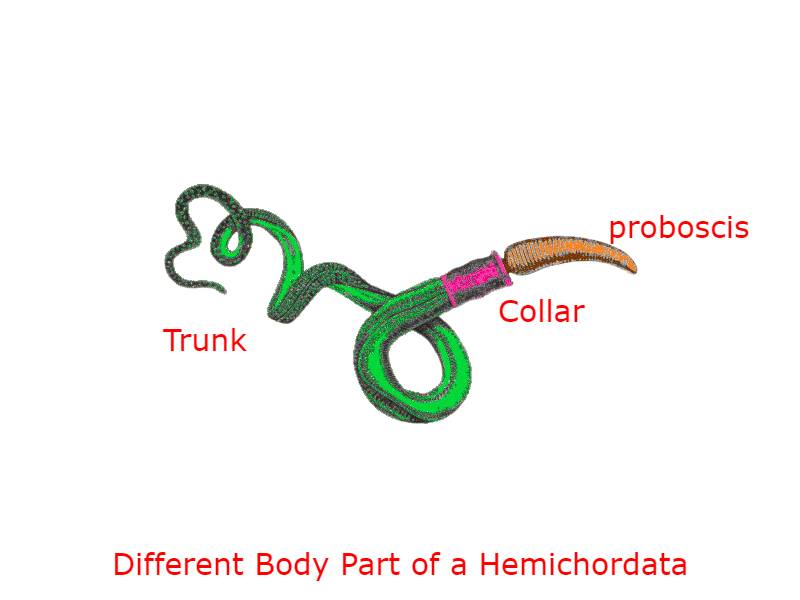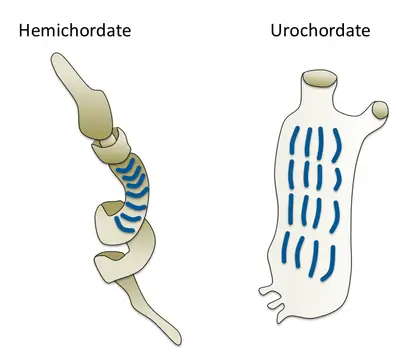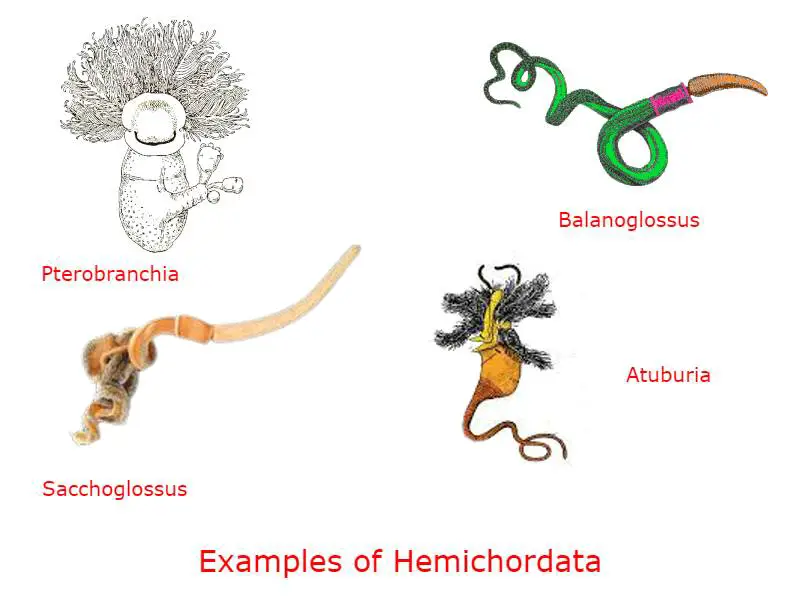Hemichordata is a subphylum under phylum Chordata, the term Hemichordata is related to two words, Hemi means half, and cord represents notochord. So Hemichordata contains those animals who do not have a notochord throughout the length of the body. Hemichordata is the most primitive Chordata and we will discuss all the general characteristics features of subphylum Hemichordata —
Table of Contents
Habitat of Hemichordata:
Members of Hemichordata live in marine environments, they live in colonial form or may live solitarily. Hemichordata generally lives in coastal areas in the burrows or under the stone and among the seaweeds.
External Appearance of Hemichordata:
Hemichordata have a vermiform body shape, the body is not segmented, the body is covered by soft and smooth glandular skin. The body is bilaterally symmetrical due to the position of different organs in its body.
Germ Layers of Hemichordata:
Hemichordata is triploblastic, all the tissues develop from three germ layers during embryonic development.
Body Part of Hemichordata:
The vermiform body of the Hemichordata has three distinct body parts, anterior most proboscis or protosome, middle collar or mesosome and posterior part is metasome or trunk.

Body Wall of Hemichordata:
In Hemichordata body wall is thick and tough, the body wall has an upper layer epidermis, muscular layer, and basement membrane. The epidermis in Hemichordata is made of glandular columnar cells in a single layer. Below the epidermis basement membrane present, below basement membrane thick muscular layer present. The dermis layer is absent in Hemichordata, below the epidermis nerve plexus present.
Coelom in Hemichordata:
In Hemichordata coelom is enterocoelous type, during embryonic development archenteron form the coelom or body cavity in Hemichordata.
In Hemichordata the coelom in proboscis, collar, and trunk are separated from each other, a total of five body cavities are present in Hemichordata which is actually coelom.
In proboscis, only one cavity is present which is known as protocoel, in the collar region two lateral body cavities are present which is known as mesocoel, in the trunk region two lateral trunk coelom or metacoel present.
Digestive System of Hemichordata:
The digestive system starts from the mouth opening and ends at the anus, digestive system is complete and it may be straight or U-shaped. In Hemichordata buccal cavity has a hollow tubular outgrowth into the proboscis coelom which is known as the buccal diverticulum.
Previously buccal diverticulum was considered as notochord or stomochord but later it becomes clear that the so-called notochord is made of the tissues of the buccal cavity. Then it becomes clear that the major Chordata character in Chordata, the notochord is absent in Hemichordata.
Respiration in Hemichordata:
In Hemichordata respiration occur through gill slits and the number of gill slits varies from one pair to several pairs. The number of gill slits increases with age and the gill slits present dorsolaterally in their trunk region.

Food Habits of Hemichordata:
Hemichordata takes food from the seawater and they show a ciliary feeding mechanism, cilia present on their gill slits generate water current, and the cilia present on their proboscis help in collecting food.
Circulatory System of Hemichordata:
The circulatory system is an open type in Hemichordata, circulatory fluid is colorless, respiratory pigment is absent. A dorsal heart pumps blood throughout the body and there are two main blood vessels, one dorsal vessel on the dorsal side and another one is the ventral vessel on the ventral side.
Excretion in Hemichordata:
In Hemichordata excretory organ is the proboscis gland or glomerulus in the proboscis region and the excretory material goes outside through the proboscis pore present in the collar stalk region.
Nervous System in Hemichordata:
In Hemichordata nervous system is epidermal, the nerve fibers and nerve cells are present under the epidermal layers. Two nerve cords are present along the length of their body, one on the dorsal side dorsal cord and another one is on the ventral side ventral cord, the dorsal nerve cord comes outside of the epidermis in the collar region which is known as the collar cord. The collar cord is hollow and has a cavity known as neurocoel similar to the Chordata nerve cord.

Reproduction and Development in Hemichordata:
In Hemichordata reproduction occur through asexual and sexual mode but they generally reproduce sexually. They have great power of regeneration, males and females are separate and fertilization is external. Development may be direct or indirect, in indirect development Tornaria larva is observed.
Reference Characteristics Features of Hemichordata
Detailed Information on
What is Balanoglossus: A Tongue Worm
External Morphology of Balanoglossus
Coelom and Coelomic Fluid in Balanoglossus
Digestive System of Balanoglossus
Respiratory System of Balanoglossus
Blood Vascular System of Balanoglossus
Balanoglossus: Excretory, Reproductive and Nervous Systems
Affinities of Balanoglossus with Chordata
Affinities of Balanoglossus with Rhynchocephalia, Phoronida, and Pogonophora
Hi Everyone!!! Welcome to Imaluop. Imaluop always try to learn some new and he want to share to other people. Here we will try to learn various topics on Science, specially on Biological Sciences.